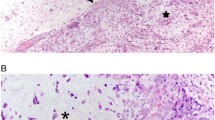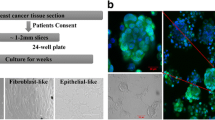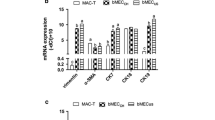Abstract
As an experimental model, most studies rely on established human cancer cell lines; however, some genetical or phenotypical differences exist between these cells and their original tumor. Therefore, primary cells isolated directly from tissue are believed to be more biologically relevant tools for studying human and animal biology. Here, we aimed to isolate primary epithelial cancer and normal cells from breast tumors of Iranian women, for the first time. Thus, we isolated the epithelial and fibroblast cells from biopsy samples of patients with breast cancer based on differential centrifugation followed by culture in selective media. Normal epithelial cells obtained from the tissue biopsy away from the core of the tumor, based on the pathological diagnosis. Flow cytometry analysis indicated the positive immunoreactivity of the isolated epithelial cells against CD24 and Epithelial Specific Antigen (ESA/EpCAM), while they displayed a concomitant low expression of CD44 and CD49f. In contrat to fibroblasts, the qPCR data indicated the expression of luminal intracellular cytokeratin (Ck18) in both normal and cancer epithelial cells, but there was no expression of myoepithelial/basal markers, CK5 and vimentin. The epithelial cancer cells were reactive to cytokeratin 19 (CK19) antibody, whereas the normal epithelial cells were not. The expression of calmodulin-like protein (CLP) was also lower in the cancer epithelial cells than in the normal ones. In conclusion, primary epithelial normal and cancer cells, in addition to the fibroblasts were isolated and characterized from breast tumor of Iranian patients; and CLP expression is suggested as a susceptibility marker for breast cancer screening.





Similar content being viewed by others
References
Aigner S, Sthoeger ZM, Fogel M, Weber E, Zarn J, Ruppert M, Zeller Y, Vestweber D, Stahel R, Sammar M, Altevogt P (1997) CD24, a mucin-type glycoprotein, is a ligand for P-selectin on human tumor cells. Blood 89:3385–3395
Alberg AJ, Singh S (2001) Epidemiology of breast cancer in older women: implications for future healthcare. Drugs Aging 18:761–772
Al-Hajj M, Wicha MS, Benito-Hernandez A, Morrison SJ, Clarke MF (2003) Prospective identification of tumorigenic breast cancer cells. Proc Natl Acad Sci USA 100:3983–3988
Band V, Sager R (1989) Distinctive traits of normal and tumor-derived human mammary epithelial cells expressed in a medium that supports long-term growth of both cell types. Proc Natl Acad Sci USA 86:1249–1253
Bartlett J, Going JJ, Mallon EA, Watters AD, Reeves JR, Stanton P, Richmond J, Donald B, Ferrier R, Cooke TG (2001) Evaluating HER2 amplification and overexpression in breast cancer. J Pathol 195:422–428
Berchtold MW, Koller M, Egli R, Rhyner JA, Hameister H, Strehler EE (1993) Localization of the intronless gene coding for calmodulin-like protein CLP to human chromosome 10p13-ter. Hum Genet 90:496–500
Berwald Y, Sachs L (1963) In vitro cell transformation with chemical carcinogens. Nature 200:1182–1184
Bircan S, Kapucuoglu N, Baspinar S, Inan G, Candir O (2006) CD24 expression in ductal carcinoma in situ and invasive ductal carcinoma of breast: an immunohistochemistry-based pilot study. Pathol Res Pract 202:569–576
Bouzakri K, Roques M, Gual P, Espinosa S, Guebre-Egziabher F, Riou J-P, Laville M, Le Marchand-Brustel Y, Tanti J-F, Vidal H (2003) Reduced activation of phosphatidylinositol-3 kinase and increased serine 636 phosphorylation of insulin receptor substrate-1 in primary culture of skeletal muscle cells from patients with type 2 diabetes. Diabetes 52:1319–1325
Brooks MD, Bennett RD, Strehler EE, Sebo TJ, Eckert SE, Carr AB (2009) Human calmodulin-like protein (CLP) expression in oral squamous mucosa and in malignant transformation. J Prosthodont 18:11–16
Brooks MD, Bennett RD, Weaver AL, Sebo TJ, Eckert SE, Strehler EE and Carr AB (2013) Human calmodulin-like protein CALML3: a novel marker for normal oral squamous mucosa that is downregulated in malignant transformation. Int J Dent 2013:592843. https://doi.org/10.1115/2013/592843
Cariati M, Naderi A, Brown JP, Smalley MJ, Pinder SE, Caldas C, Purushotham AD (2008) Alpha-6 integrin is necessary for the tumourigenicity of a stem cell-like subpopulation within the MCF7 breast cancer cell line. Int J Cancer 122:298–304
Coughlin SS, Ekwueme DU (2009) Breast cancer as a global health concern. Cancer Epidemiol 33:315–318
Durussel I, Rhyner JA, Strehler EE, Cox JA (1993) Cation binding and conformation of human calmodulin-like protein. Biochemistry 32:6089–6094
Edman CF, George SE, Means AR, Schulman H, Yaswen P (1994) Selective activation and inhibition of calmodulin-dependent enzymes by a calmodulin-like protein found in human epithelial cells. Eur J Biochem 226:725–730
Ethier SP, Ammerman CA, Dziubinski ML (2000) Isolation and culture of human breast cancer cells from primary tumors and metastases. In: Ip MM, Asch BB (eds) Methods in mammary gland biology and breast cancer research. Springer, Boston, MA
Ferlay J, Shin HR, Bray F, Forman D, Mathers C, Parkin DM (2010) Estimates of worldwide burden of cancer in 2008: GLOBOCAN 2008. Int J Cancer 127:2893–2917
Ferlay J, Soerjomataram I, Dikshit R, Eser S, Mathers C, Rebelo M, Parkin DM, Forman D, Bray F (2015) Cancer incidence and mortality worldwide: sources, methods and major patterns in GLOBOCAN 2012. Int J Cancer 136:E359–E386
Freshney RI (1986) Animal cell culture: a practical approach. IRL Press, Oxford
Gamel JW, Vogel RL (2001) Non-parametric comparison of relative versus cause-specific survival in Surveillance, Epidemiology and End Results (SEER) programme breast cancer patients. Stat Methods Med Res 10:339–352
Gordon KE, Binas B, Chapman RS, Kurian KM, Clarkson RW, Clark AJ, Lane EB, Watson CJ (2000) A novel cell culture model for studying differentiation and apoptosis in the mouse mammary gland. Breast Cancer Res 2:222
Gosens MJ, van Kempen LC, van de Velde CJ, van Krieken JHJ, Nagtegaal ID (2007) Loss of membranous Ep-CAM in budding colorectal carcinoma cells. Mod Pathol 20:221–232
Hammond SL, Ham RG, Stampfer MR (1984) Serum-free growth of human mammary epithelial cells: rapid clonal growth in defined medium and extended serial passage with pituitary extract. Proc Natl Acad Sci USA 81:5435–5439
Harris RE, Namboodiri KK, Wynder EL (1992) Breast cancer risk: effects of estrogen replacement therapy and body mass. J Natl Cancer Inst 84:1575–1582
Henderson IC (1993) Risk factors for breast cancer development. Cancer 71:2127–2140
Henson DE, Tarone RE (1994) Involution and the etiology of breast cancer. Cancer 74:424–429
Herlyn M, Steplewski Z, Herlyn D, Koprowski H (1979) Colorectal carcinoma-specific antigen: detection by means of monoclonal antibodies. Proc Natl Acad Sci USA 76:1438–1442
Honeth G, Bendahl P-O, Ringnér M, Saal LH, Gruvberger-Saal SK, Lovgren K, Grabau D, Ferno M, Borg A, Hegardt C (2008) The CD44 +/CD24-phenotype is enriched in basal-like breast tumors. Breast Cancer Res 10:R53
Hopper JL (2001) Genetic epidemiology of female breast cancer. Semin Cancer Biol 11:367–374
Jazayeri SB, Saadat S, Ramezani R, Kaviani A (2015) Incidence of primary breast cancer in Iran: ten-year national cancer registry data report. Cancer Epidemiol 39:519–527
Johanson JF (2001) Critical review of the epidemiology of gastroesophageal reflux disease with specific comparisons to asthma and breast cancer. Am J Gastroenterol 96:S19–S21
Keller PJ, Lin AF, Arendt LM, Klebba I, Jones AD, Rudnick JA, DiMeo TA, Gilmore H, Jefferson DM, Graham RA (2010) Mapping the cellular and molecular heterogeneity of normal and malignant breast tissues and cultured cell lines. Breast Cancer Res 12:R87
Key TJ, Verkasalo PK, Banks E (2001) Epidemiology of breast cancer. Lancet Oncol 2:133–140
Kristiansen G, Sammar M, Altevogt P (2004) Tumour biological aspects of CD24, a mucin-like adhesion molecule. J Mol Histol 35:255–262
Leccia F, Nardone A, Corvigno S, Vecchio LD, De Placido S, Salvatore F, Veneziani BM (2012) Cytometric and biochemical characterization of human breast cancer cells reveals heterogeneous myoepithelial phenotypes. Cytometry Part A 81:960–972
Lee SW, Tomasetto C, Swisshelm K, Keyomarsi K, Sager R (1992) Down-regulation of a member of the S100 gene family in mammary carcinoma cells and reexpression by azadeoxycytidine treatment. Proc Natl Acad Sci USA 89:2504–2508
Lehmann-Che J, Amira-Bouhidel F, Turpin E, Antoine M, Soliman H, Legres L, Bocquet C, Bernoud R, Flandre E, Varna M (2011) Immunohistochemical and molecular analyses of HER2 status in breast cancers are highly concordant and complementary approaches. Br J Cancer 104:1739–1746
Lesley J, Hyman R, Kincade PW (1992) CD44 and its interaction with extracellular matrix. Adv Immunol 54:271–335
Li C (2010) Breast cancer epidemiology. Springer, Berlin
Lim S (2005) CD24 and human carcinoma: tumor biological aspects. Biomed Pharmacother 59:S351–S354
Liu R, Wang X, Chen GY, Dalerba P, Gurney A, Hoey T, Sherlock G, Lewicki J, Shedden K, Clarke MF (2007) The prognostic role of a gene signature from tumorigenic breast-cancer cells. N Engl J Med 356:217–226
Liu Z, Miner JJ, Yago T, Yao L, Lupu F, Xia L, McEver RP (2010) Differential regulation of human and murine P-selectin expression and function in vivo. J Exp Med 207:2975–2987
Martz E, Phillips H, Steinberg M (1974) Contact inhibition of overlapping and differential cell adhesion: a sufficient model for the control of certain cell culture morphologies. J Cell Sci 16:401–419
Mennan C, Wright K, Bhattacharjee A, Balain B, Richardson J, Roberts S (2013) Isolation and characterisation of mesenchymal stem cells from different regions of the human umbilical cord. Biomed Res Int 2013:916136. https://doi.org/10.1155/2013/916136
Movahedi M, Haghighat S, Khayamzadeh M, Moradi A, Ghanbari-Motlagh A, Mirzaei H, Esmail-Akbari M (2012) Survival rate of breast cancer based on geographical variation in Iran, a national study. Iran Red Crescent Med J 14:798
Munz M, Fellinger K, Hofmann T, Schmitt B, Gires O (2007) Glycosylation is crucial for stability of tumour and cancer stem cell antigen EpCAM. Front Biosci J Virtual Libr 13:5195–5201
Neve RM, Chin K, Fridlyand J, Yeh J, Baehner FL, Fevr T, Clark L, Bayani N, Coppe J-P, Tong F (2006) A collection of breast cancer cell lines for the study of functionally distinct cancer subtypes. Cancer Cell 10:515–527
Pauli C, Münz M, Kieu C, Mack B, Breinl P, Wollenberg B, Lang S, Zeidler R, Gires O (2003) Tumor-specific glycosylation of the carcinoma-associated epithelial cell adhesion molecule EpCAM in head and neck carcinomas. Cancer Lett 193:25–32
Perou CM, Sørlie T, Eisen MB, van de Rijn M, Jeffrey SS, Rees CA, Pollack JR, Ross DT, Johnsen H, Akslen LA (2000) Molecular portraits of human breast tumours. Nature 406:747–752
Phuchareon J, Ohta Y, Woo JM, Eisele DW, Tetsu O (2009) Genetic profiling reveals cross-contamination and misidentification of 6 adenoid cystic carcinoma cell lines: ACC2, ACC3, ACCM, ACCNS, ACCS and CAC2. PLoS ONE 4:e6040
Rhyner JA, Koller M, Durussel-Gerber I, Cox JA, Strehler EE (1992) Characterization of the human calmodulin-like protein expressed in Escherichia coli. Biochemistry 31:12826–12832
Rogers MS, Strehler EE (2001) The tumor-sensitive calmodulin-like protein is a specific light chain of human unconventional myosin X. J Biol Chem 276:12182–12189
Rogers MS, Foleyt MA, Crotty TB, Hartmannt LC, Ingle JN, Roche PC, Strehler EE (1999) Loss of immunoreactivity for human calmodulin-like protein is an early event in breast cancer development. Neoplasia 1:220–225
Romano P, Manniello A, Aresu O, Armento M, Cesaro M, Parodi B (2009) Cell line data base: structure and recent improvements towards molecular authentication of human cell lines. Nucleic Acids Res 37:D925–D932
Ronnov-Jessen L, Petersen OW, Bissell MJ (1996) Cellular changes involved in conversion of normal to malignant breast: importance of the stromal reaction. Physiol Rev 76:69–125
Rosner B, Gore R (2001) Measurement error correction in nutritional epidemiology based on individual foods, with application to the relation of diet to breast cancer. Am J Epidemiol 154:827–835
Samsel L, Zaidel G, Drumgoole HM, Jelovac D, Drachenberg C, Rhee JG, Brodie AM, Bielawska A, Smyth MJ (2004) The ceramide analog, B13, induces apoptosis in prostate cancer cell lines and inhibits tumor growth in prostate cancer xenografts. Prostate 58:382–393
Schmidt M, Hasenclever D, Schaeffer M, Boehm D, Cotarelo C, Steiner E, Lebrecht A, Siggelkow W, Weikel W, Schiffer-Petry I (2008) Prognostic effect of epithelial cell adhesion molecule overexpression in untreated node-negative breast cancer. Clin Cancer Res 14:5849–5855
Schmittgen TD, Livak KJ (2008) Analyzing real-time PCR data by the comparative CT method. Nat Protoc 3:1101–1108
Shah K (2015) Primary cells versus cell lines. https://sciencellonline.com/blog/primary-cells-versus-cell-lines/. Retrieved 27 Feb 2017
Shi S-R, Cote RJ, Taylor CR (1997) Antigen retrieval immunohistochemistry: past, present, and future. J Histochem Cytochem 45:327–343
Shipitsin M, Campbell LL, Argani P, Weremowicz S, Bloushtain-Qimron N, Yao J, Nikolskaya T, Serebryiskaya T, Beroukhim R, Hu M (2007) Molecular definition of breast tumor heterogeneity. Cancer Cell 11:259–273
Siegel RL, Miller KD, Jemal A (2016) Cancer statistics, 2016. CA Cancer J Clin 66:7–30
Sleeman KE, Kendrick H, Ashworth A, Isacke CM, Smalley MJ (2005) CD24 staining of mouse mammary gland cells defines luminal epithelial, myoepithelial/basal and non-epithelial cells. Breast Cancer Res 8:R7
Sorlie T, Perou CM, Tibshirani R, Aas T, Geisler S, Johnsen H, Hastie T, Eisen M, Van de Rijn M, Jeffrey S (2001) Gene expression patterns of breast carcinomas distinguish tumor subclasses with clinical implications. Proc Natl Acad Sci USA 98:10869–10874
Sørlie T, Perou CM, Tibshirani R, Aas T, Geisler S, Johnsen H, Hastie T, Eisen MB, Van De Rijn M, Jeffrey SS (2001) Gene expression patterns of breast carcinomas distinguish tumor subclasses with clinical implications. Proc Natl Acad Sci USA 98:10869–10874
Sørlie T, Tibshirani R, Parker J, Hastie T, Marron J, Nobel A, Deng S, Johnsen H, Pesich R, Geisler S (2003) Repeated observation of breast tumor subtypes in independent gene expression data sets. Proc Natl Acad Sci USA 100:8418–8423
Speirs V, Green AR, White MC (1996) A comparative study of cytokine gene transcripts in normal and malignant breast tissue and primary cell cultures derived from the same tissue samples. Int J Cancer 66:551–556
Speirs V, Green A, Walton D, Kerin M, Fox J, Carleton P, Desai S, Atkin S (1998) Short-term primary culture of epithelial cells derived from human breast tumours. Br J Cancer 78:1421–1429
Spizzo G, Went P, Dirnhofer S, Obrist P, Moch H, Baeuerle PA, Mueller-Holzner E, Marth C, Gastl G, Zeimet AG (2006) Overexpression of epithelial cell adhesion molecule (Ep-CAM) is an independent prognostic marker for reduced survival of patients with epithelial ovarian cancer. Gynecol Oncol 103:483–488
Taghavi A, Fazeli Z, Vahedi M, Baghestani AR, Pourhoseingholi A, Barzegar F, Pourhoseingholi MA (2012) Increased trend of breast cancer mortality in Iran. Asian Pac J Cancer Prev 13:367–370
Tan P-H, Bay B-H, Yip G, Selvarajan S, Tan P, Wu J, Lee C-H, Li K-B (2005) Immunohistochemical detection of Ki67 in breast cancer correlates with transcriptional regulation of genes related to apoptosis and cell death. Mod Pathol 18:374–381
Taylor-Papadimitriou J, Stampfer M, Bartek J, Lewis A, Boshell M, Lane E, Leigh I (1989) Keratin expression in human mammary epithelial cells cultured from normal and malignant tissue: relation to in vivo phenotypes and influence of medium. J Cell Sci 94:403–413
Vineis P, Wild CP (2014) Global cancer patterns: causes and prevention. Lancet 383:549–557
Went P, Vasei M, Bubendorf L, Terracciano L, Tornillo L, Riede U, Kononen J, Simon R, Sauter G, Baeuerle P (2006) Frequent high-level expression of the immunotherapeutic target Ep-CAM in colon, stomach, prostate and lung cancers. Br J Cancer 94:128–135
Winter MJ, Nagtegaal ID, van Krieken JHJ, Litvinov SV (2003) The epithelial cell adhesion molecule (Ep-CAM) as a morphoregulatory molecule is a tool in surgical pathology. Am J Pathol 163:2139–2148
Yaswen P, Smoll A, Peehl DM, Trask DK, Sager R, Stampfer MR (1990) Down-regulation of a calmodulin-related gene during transformation of human mammary epithelial cells. Proc Natl Acad Sci USA 87:7360–7364
ZenBio Scientific Publications (2015) Primary cell culture: the game has changed! ZenBio Scientific Publications. http://www.zen-bio.com/pdf/PrimaryCells_whitepaper_ZenBio.pdf. Retrieved 27 Feb 2017
Zhao H, Langerød A, Ji Y, Nowels KW, Nesland JM, Tibshirani R, Bukholm IK, Kåresen R, Botstein D, Børresen-Dale A-L (2004) Different gene expression patterns in invasive lobular and ductal carcinomas of the breast. Mol Biol Cell 15:2523–2536
Acknowledgements
This project was supported and funded by Iranian national Science Foundation (INSF) project No. 93036700. The authors are also thank full of the Research Console of Tarbiat Modares University for their support of this project. The authors are very thankful of Dr. Laleh Nikfarjam for her intellectual help during separation of the mentioned cells.
Author information
Authors and Affiliations
Corresponding author
Rights and permissions
About this article
Cite this article
Faridi, N., Bathaie, S.Z., Abroun, S. et al. Isolation and characterization of the primary epithelial breast cancer cells and the adjacent normal epithelial cells from Iranian women’s breast cancer tumors. Cytotechnology 70, 625–639 (2018). https://doi.org/10.1007/s10616-017-0159-3
Received:
Accepted:
Published:
Issue Date:
DOI: https://doi.org/10.1007/s10616-017-0159-3




